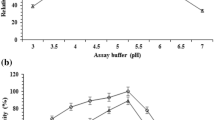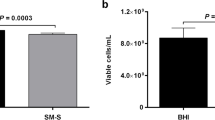Abstract
The pathogenic fungus Candida glabrata is thought to utilize extracellular sterols during infection, but there have been few reports on the sterol uptake mechanisms of this fungus. The addition of serum promoted the growth of C. glabrata cells in the presence of the sterol inhibitor fluconazole, probably as the result of incorporation of cholesterol from serum. We demonstrated that lipoprotein-deficient serum, in which most of the cholesterol was eliminated, could not rescue the growth of fluconazole-treated C. glabrata cells, but it successfully promoted the expression of the sterol transporter gene AUS1. After supplementation of free cholesterol to lipoprotein-deficient serum, the serum was again competent to promote the growth of fluconazole-treated C. glabrata. The serum-mediated growth rescue from fluconazole inhibition was observed in the nonpathogenic yeast Saccharomyces cerevisiae when it was followed by the activation of anaerobic sterol uptake. These results suggested that serum cholesterol was incorporated into yeast cells to compensate for sterol depletion when sterol uptake was activated. The uptake of serum cholesterol could support the growth of C. glabrata cells during bloodstream infections.



Similar content being viewed by others
References
Odds FC, Brown AJP, Gow NAR. Antifungal agents: mechanisms of action. Trends Microbiol. 2003;11:272–9.
Wilcox LJ, Balderes DA, Wharton B, Tinkelenberg AH, Rao G, Sturley SL. Transcriptional profiling identifies two members of the ATP-binding cassette transporter superfamily required for sterol uptake in yeast. J Biol Chem. 2002;277:32466–72.
Li Y, Prinz WA. ATP-binding cassette (ABC) transporters mediate nonvesicular, raft-modulated sterol movement from the plasma membrane to the endoplasmic reticulum. J Biol Chem. 2004;279:45226–34.
Lorenz RT, Parks LW. Involvement of heme components in sterol metabolism of Saccharomyces cerevisiae. Lipids. 1991;26:598–603.
Alimardani P, Régnacq M, Moreau-Vauzelle C, Ferreira T, Rossignol T, Blondin B, et al. SUT1-promoted sterol uptake involves the ABC transporter Aus1 and the mannoprotein Dan1 whose synergistic action is sufficient for this process. Biochem J. 2004;381:195–202.
Nakayama H, Tanabe K, Bard M, Hodgson W, Wu S, Takemori D, et al. The Candida glabrata putative sterol transporter gene CgAUS1 protects cells against azoles in the presence of serum. J Antimicrob Chemother. 2007;60:1264–72.
Bard M, Sturm AM, Pierson CA, Brown S, Rogers KM, Nabinger S, et al. Sterol uptake in Candida glabrata: rescue of sterol auxotrophic strains. Diagn Microbiol Infect Dis. 2005;52:285–93.
Hazen KC, Stei J, Darracott C, Breathnach A, May J, Howell SA. Isolation of cholesterol-dependent Candida glabrata from clinical specimens. Diagn Microbiol Infect Dis. 2005;52:35–7.
Brown WH, Stull JW. Bovine serum lipid analysis 1. J Dairy Sci. 1966;49:636–41.
Andreasen AA, Stier TJB. Anaerobic nutrition of Saccharomyces cerevisiae. I. Ergosterol requirement for growth in a defined medium. J Cell Physiol. 1953;41:23–36.
Nagi M, Nakayama H, Tanabe K, Bard M, Aoyama T, Okano M, et al. Transcription factors CgUPC2A and CgUPC2B regulate ergosterol biosynthetic genes in Candida glabrata. Genes Cells. 2011;16:80–9.
Bligh EG, Dyer WJ. A rapid method of total lipid extraction and purification. Can J Biochem Physiol. 1959;37:911–7.
Lewis TA, Rodriguez RJ, Parks LW. Relationship between intracellular sterol content and sterol esterification and hydrolysis in Saccharomyces cerevisiae. Biochim Biophys Acta. 1987;921:205–12.
Nagi M, Tanabe K, Takano Y, Kikuchi K, Miyazaki Y, Niimi M. Serum or bile affects the in vitro azole susceptibilities of Candida spp. Jpn J Infect Dis. 2009;62:306–8.
Kwast KE, Lai L-C, Menda N, James DT, Aref S, Burke PV. Genomic analyses of anaerobically induced genes in Saccharomyces cerevisiae: functional roles of Rox1 and other factors in mediating the anoxic response. J Bacteriol. 2002;184:250–65.
Fidel PL, Vazquez JA, Sobel JD. Candida glabrata: review of epidemiology, pathogenesis, and clinical disease with comparison to C. albicans. Clin Microbiol Rev. 1999;12:80–96.
Grahl N, Shepardson KM, Chung D, Cramer RA. Hypoxia and fungal pathogenesis: to air or not to air? Eukaryot Cell. 2012;11:560–70.
Parks LW, Casey WM. Physiological implications of sterol biosynthesis in yeast. Annu Rev Microbiol. 1995;49:95–116.
Acknowledgments
This work was supported by JSPS KAKENHI Grant Number 24790428 (KT), 2459054 (NH), 21390305 (YM), 24.9439 (MN), the grant from the Ministry of Health, Labour and Welfare of Japan H22-shinko-ippan-008, H23-shinko-ippan-018, H23-shinko-ippan-007 and H24-shinko-ippan-013 (YM). We thank R. Fukuda for providing yeast strains. The authors thank Enago (http://www.enago.jp) for English language review.
Conflict of interest
There is no conflict of interest to be declared in this manuscript.
Author information
Authors and Affiliations
Corresponding author
Additional information
M. Nagi and K. Tanabe contributed equally to this work.
About this article
Cite this article
Nagi, M., Tanabe, K., Nakayama, H. et al. Serum cholesterol promotes the growth of Candida glabrata in the presence of fluconazole. J Infect Chemother 19, 138–143 (2013). https://doi.org/10.1007/s10156-012-0531-3
Received:
Accepted:
Published:
Issue Date:
DOI: https://doi.org/10.1007/s10156-012-0531-3




